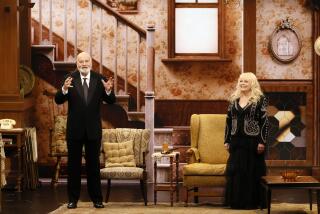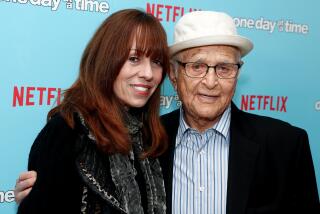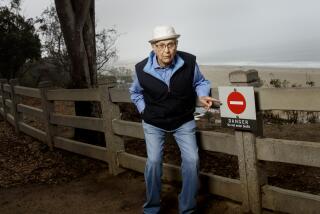‘Mary Hartman,’ one more time
- Share via
Producer Norman Lear had turned the family sitcom on its head in 1971 with his groundbreaking CBS comedy series “All in the Family.” Five years later, he revolutionized the soap opera with his weeknight satire “Mary Hartman, Mary Hartman,” starring Louise Lasser as a suburban housewife living in the fictional town of Fernwood, Ohio, obsessed with Reader’s Digest and consumerism.
In fact, in the series’ first episode, Mary’s more concerned about the waxy yellow buildup on her kitchen floor than an entire family — plus their goats and chickens — having been murdered in her neighborhood.
Lear said recently that with “Mary Hartman” he wanted to explore “what is the media doing to the average American housewife? How was the media deadening them?”
PHOTOS: Life after ‘Mary Hartman’
Though she may have been striving for domestic perfection, Mary’s life was anything but bliss. Her factory worker husband, Tom (Greg Mullavey), was impotent; her grandfather (Victor Kilian) was the Fernwood Flasher and her sister, Cathy (Debralee Scott), was man-crazy. Mary’s eternally optimistic best friend, Loretta (Mary Kay Place), an aspiring country-western singer, was one of the few rays of sunshine in her life.
Just like “All in the Family,” the series quickly became part of the cultural landscape, making the covers of Newsweek, TV Guide, Rolling Stone, People and the New York Times Sunday Magazine.
“It was a tsunami of emotions and opportunities,” recalled Place, who won an Emmy for her role.
To Lasser it was like “being a little girl and you imagine what your want in your life, and then all of a sudden everyone is saying, ‘we love you.’”
On Tuesday, Shout! Factory is releasing all 325 episodes of the series that ran for two seasons on a 38-disc set. Paley Center for Media curator Ron Simon said the timing of the series was perfect.
PHOTOS: Behind-the-scenes Classic Hollywood
“In many ways, it is a good exploration of where America was in the bicentennial year,” he said. “The show comes out of the Watergate era, where the country is still very introspective, trying to understand what is happening.”
Though Lear didn’t conceive the series with Lasser in mind, it’s hard to picture anyone else playing the frazzled housewife who sported long braided hair and dressed as if she was still a young girl.
“She was so raw,” said Lasser of Mary. “She had so much going on in her life, she didn’t know what she felt about anything. I was the personification of Norman’s America. She was a bipolar character, but it took me a while to discover it.”
The series was a hard sell for Lear.
Writers, Lear said, “just didn’t understand how this could be funny.” Then writer Ann Marcus came in, and “she got it,” Lear said. And so did Joan Darling, one of the series’ main directors.
“If we didn’t have Joan, it wouldn’t have been this,” Lasser noted.
Despite Lear’s track record, the broadcast networks turned it down. “It didn’t have a laugh track, and networks wanted one,” Simon said. “Others wanted it to be a weekly series.”
PHOTOS: Behind the scenes of movies and TV
The adult subject matter also made the broadcast networks skittish. So Lear sold the series to independent stations. “You were part of the ‘Mary Hartman, Mary Hartman’ network because it was the only show that was pulling of all these stations together,” Lear said.
“I look at it as a precursor to cable TV,” Place said.
Perhaps the most famous episode in the series was the first-season finale, which finds Mary suffering a nervous breakdown on “The David Susskind Show.” Lasser’s gut wrenching performance — the 11-minute breakdown was shot in one take — is almost shockingly intense.
“That was planned from the beginning, that she going to explode at some point,” Lear said.
Lasser recalled she was asked “what do you think should happen next? I remember I said, ‘I think she has to have nervous breakdown.’ I don’t know how much anyone can endure like that.”
It was also hard for the cast and crew to endure the pace of the series. “There was a lot of pressure,” Place said. “We did 35 scenes a day. We were totally wasted to the core.”
After two seasons, Lasser said, “I couldn’t do it anymore.”
More to Read
The complete guide to home viewing
Get Screen Gab for everything about the TV shows and streaming movies everyone’s talking about.
You may occasionally receive promotional content from the Los Angeles Times.







